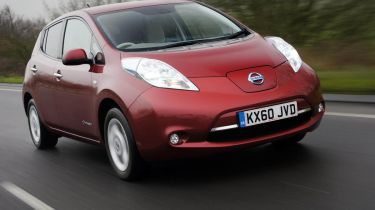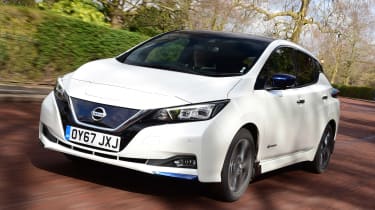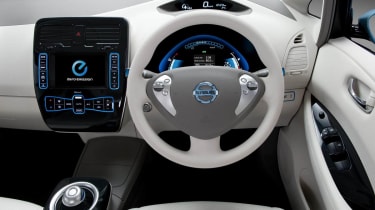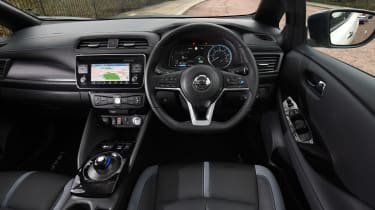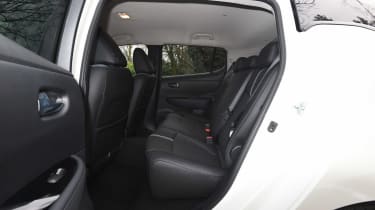Nissan Leaf hatchback: old vs new
The mk1 Nissan Leaf was the world's best-selling electric car - how does the new one compare?
Nissan's aim over the last decade has been to produce a top-selling electric car and it succeeded with the first Nissan Leaf, with more than 500,000 sold globally. Easy to drive, quiet and cheap to run, the original has won many fans and proved extremely reliable.
While almost in a class of one when it arrived, the latest model now faces considerably more rivals, including the Hyundai Ioniq Electric, MG ZS EV, Volkswagen ID.3 and Tesla Model 3.
Best electric cars on sale now
The new Nissan Leaf isn't as quirky as the first generation, instead aiming to appeal to a wider audience. Indeed, its vastly improved range, performance and practicality mean it's ready to take on mainstream rivals like the Volkswagen Golf.
Nissan Leaf design
The design of the original Nissan Leaf was polarising when it launched in 2011, with a mixture of Nissan design cues and proportions dictated by its EV powertrain. The former included its Juke-style headlights perched above a stubby bonnet, while the underfloor battery meant the Leaf had to be made taller than conventional hatchbacks like the Ford Focus and Volkswagen Golf.
In a move to ape the distinctive Toyota Prius, which managed to take the hybrid market by storm, Nissan also gave the Leaf quirky looks with features like a smooth nose - electric motors don't need air from a big front grille - and space-age elongated rear lights.
The second-generation Leaf doesn't try to be so different, instead looking like it sits more comfortably in Nissan's line-up. Horizontal headlights, a more prominent bonnet and even a faux-grille are nods to the realisation that owners of electric cars don't necessarily want to stand out from the crowd. Clever tricks like a black roof and hatchback also make the Leaf appear lower to the ground than it really is.
Performance and running costs
Manufacturers are investing billions of pounds into electric powertrain development, and the steps forward are evidenced by the latest Nissan Leaf. The original came with a 24kWh battery pack and a claimed range of 124 miles, but in cold conditions this could plummet well below 100 miles. While perfectly fine for urban driving and most commutes, this lack of range compared with combustion cars led to 'range anxiety' for many prospective buyers, and limited the Leaf's versatility as the sole car of a household. A 30kWh car cost around £1,600 extra and improved range to just over 150 miles.
The current Leaf also comes with two battery sizes, with the smaller 40kWh giving up to 168 miles of range, while the 62kWh e+ version can return up to 239 miles on a single charge. It also supports fast charging, with the entry-level model accepting 50kW charging that nets an 80% top-up in 40 minutes. The Leaf e+ can charge at up to 100kW. The smaller size of the original Leaf's battery pack means it can also charge quite quickly, getting to around 80% in half-an-hour using a rapid charger.
With 108bhp and instant pulling power, the Mk1 Leaf feels very quick away from traffic lights, but its mediocre 0-62mph time of 11.5 seconds highlights the fact acceleration tails off at higher speeds, and it can only hit 89mph. The regular Mk2 Leaf has 148bhp and feels quite a bit faster, taking just 7.9 seconds to hit 62mph - a figure beating many petrol and diesel rivals. The Leaf e+ is even faster, getting an impressive 214bhp that cuts its acceleration sprint to 6.9 seconds and raises its top speed to 98mph.
Interior
The original Nissan Leaf's interior was similarly experimental, with plenty of quirks compared to Nissan's other cars. It was lightly coloured for a start, giving it a fresh feel, while the badge on the steering wheel is tinted blue to remind you it’s electric. It's also impressively quiet thanks to its electric powertrain, and Nissan famously had to spend a lot of time eradicating noises that stood out with no engine to drown them out - including designing quieter wiper motors.
Again, the newer model is more conventional, sharing its flat-bottomed steering wheel and plenty of its tech with models like the Nissan Qashqai. It's more sporty but also less distinctive. Quality is a bit of a mixed bag too, because while some of the plastics and buttons look rather cheap, everything feels sturdy and like it will be just the same in a decade. A new digital display within the instrument binnacle helps present information more readily.
Practicality
The Nissan Leaf was billed as the world's first mass produced electric car, and as a result it also had to be able to compete with family cars like the Volkswagen Golf. The result was a sizeable 370-litre boot, just 10 litres less than the VW. This should be plenty for most daily requirements but the Leaf doesn't so well if you fold down the rear seats. Space increases to 720 litres but the seats don't fold flat because of the batteries, so there's a big hump in the floor.
With a longer space between the wheels, the second Leaf is an even better bet for families. It even trumps the 380-litre boot in the Golf thanks to an impressive 435 litres of luggage volume, while the electric Volkswagen e-Golf only manages 341 litres. It's practical in other ways too, with wide-opening doors. However, there's still plenty of room for improvement because there isn't that much interior storage and the steering adjusts for height but not reach.
Safety
When electric cars first started to hit the road, there were genuine concerns they could explode in a crash or malfunction if you went through a car wash. The Nissan Leaf has helped dispel most of these anxieties, proving more reliable than most other cars. It also scored the full five stars in Euro NCAP crash testing, although this was back in 2012 - the test has been made gradually tougher since then.
The current Nissan Leaf repeated its predecessor’s success, managing a five-star Euro NCAP score in 2019 - the same rating as the popular Nissan Qashqai SUV. It also features state-of-the-art driving aids, such as the semi-autonomous ProPilot system. This allows the Leaf to speed up, slow down and steer in its lane on motorways and dual carriageways, even bringing it to a halt in heavy traffic.
Verdict
Nissan has been more conservative with the latest Leaf, helping it appeal to a wider audience than the quirky first-generation model. A significantly better range will also help buyers take the step away from petrol and diesel cars. Those who do will find a surprisingly big boot and refined, well-equipped interior. At this relatively early stage in the development of electric cars, it makes sense to go for the newest model you can afford, and that goes for the Nissan Leaf.
Read our in-depth reviews of the Nissan Leaf, along with rivals including the Hyundai Ioniq Electric, Volkswagen ID.3 and Tesla Model 3.
Recommended

New Subaru Trailseeker revealed as rugged electric SUV with 375bhp

New Subaru Solterra brings more range, power and polish
Most Popular
Tips & advice

Car dashboard warning lights: what does each symbol mean?

Electric car charging stations: public networks, charger types, apps and maps


